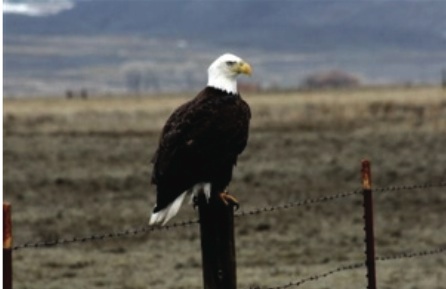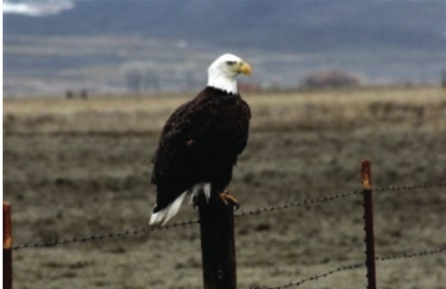
Once locally extinct bald eagles are now commonly reported ‘roadside attractions’ in northern Nevada.
While a growing eagle population has been documented by zoologists for the past decade this particularly cold and bitter winter may have forced the birds from their usual hunting grounds to scavenge off fresh road kill along I-80 and other roads through the region.
Even 20 years ago the sighting of a bald eagle in north east Nevada was national news. Once a common sight in much of the continent, the Bald Eagle was severely affected in the mid-20th century by a variety of factors, among them the thinning of egg shells attributed to use of the pesticide DDT. Bald Eagles, like many birds of prey, were especially affected by DDT due to biomagnification. DDT itself was not lethal to the adult bird, but it interfered with the bird’s calcium metabolism, making the bird either sterile or unable to lay healthy eggs. Female eagles laid eggs that were too brittle to withstand the weight of a brooding adult, making it nearly impossible for the eggs to hatch.
In addition to pesticides eagles were also shot by hunters and farmers as varmints and many fell prey to poison bait used against coyotes and foxes.
By the 1960’s the birds had vanished from most of the American sky with toeholds only in Alaska and Florida. The Bald Eagle was declared an endangered species in the U.S. in 1967, and amendments to the 1940 act between 1962 and 1972 further restricted commercial uses and increased penalties for violators. Perhaps most significant in the species’ recovery, in 1972, DDT was banned from usage in the United States.
Its comeback was helped by reintroduction programs of wounded or captive bred birds back to the wild in the 1970’s and 1980’s the most notable locally was the bird Silver and his mate Jane who were relocated to the Ruby Marshes just south of Wells in 1974. Prior to silver and Jane Bald Eagles had not been seen in the marshes for well over two decades.
 With regulations in place and DDT banned, the eagle population rebounded quickly. The Bald Eagle can be found in growing concentrations throughout the United States and Canada, particularly near large bodies of water.
With regulations in place and DDT banned, the eagle population rebounded quickly. The Bald Eagle can be found in growing concentrations throughout the United States and Canada, particularly near large bodies of water.
Bald Eagles are not the only iconic wild animals to return to Nevada. Just last summer a small herd pronghorns, the fastest North American, mammals took a mosey threw Wendover on their annual migration north for the summer.
The pronghorn can reached speeds of over 60 miles an hour for over five minutes is the pronghorn is bested only by the cheetah in a sprint. But while the cheetah can achieve 80 miles an hour, it can only sustain that speed for at best 100 yards, a pronghorn can maintain its top speed for over five minutes.
Like the eagle the 20th century was not kind to the pronghorns by the 1920’s the entire number of pronghorns was estimated to be only 13,000. Protection of habitat and hunting restrictions have allowed their numbers to recover to an estimated population of between 500,000 and 1,000,000.
In the last 50 years pronghorns have recovered almost exponentially and part of the reason like other native wildlife could be due to increased toleration of human beings.
 Described as extremely skittish well into the 1950, pronghorns like the recent visitors to Wendover have appeared to have learned that people especially those living in cities pose little threat to them.
Described as extremely skittish well into the 1950, pronghorns like the recent visitors to Wendover have appeared to have learned that people especially those living in cities pose little threat to them.
This acclimation to humans and the exploitation of new food sources is not unique to the pronghorn. The once rare desert big horn sheep is an annual winter visitor to Wendover as are mule dear and elk.
While herbivores are tolerated if not welcomed to the new human built oasis predators such as coyotes, wolves, bobcats and cougars have also tried to make inroads into areas of human habitation with often fatal results.

In a related development West Wendover Police captured a juvenile Golden Eagle near the local Post Office last week.
The bird was transfered to the Nevada Department of Wildlife offices in Wells where it received medical treatment for a stomach infection and will be released back to the wild when it recovers.
